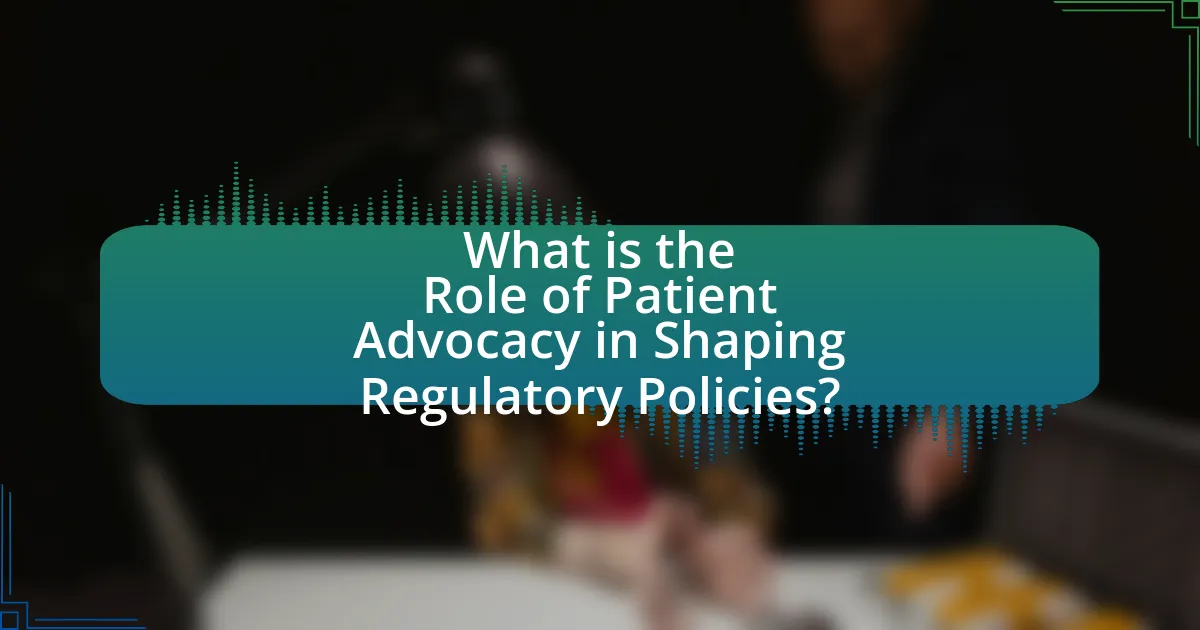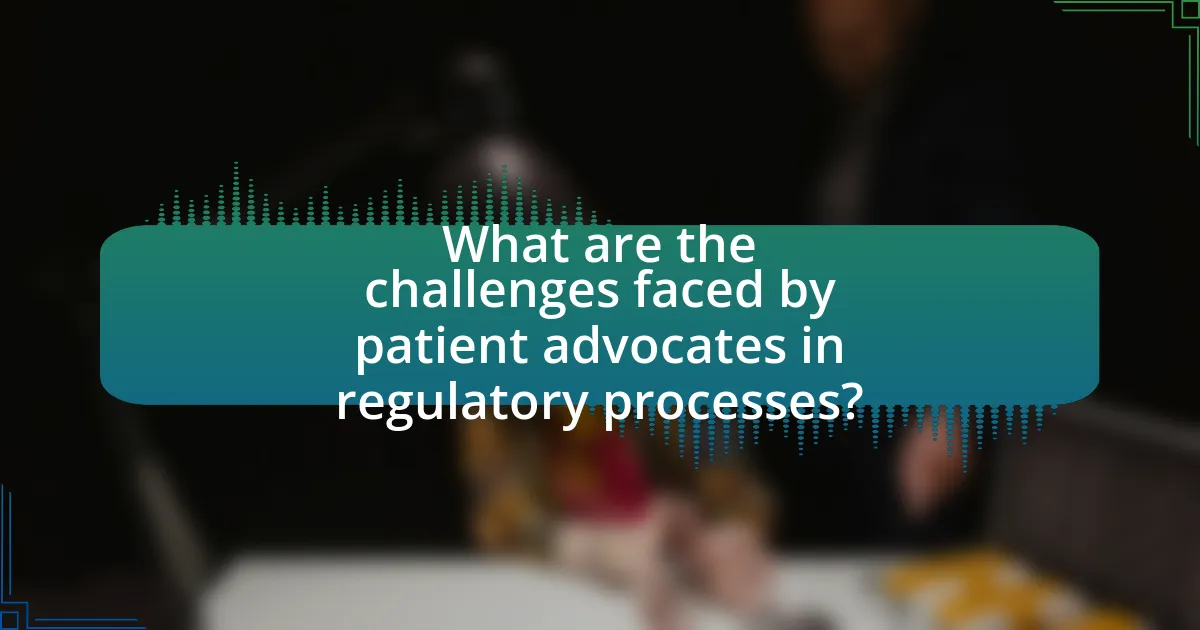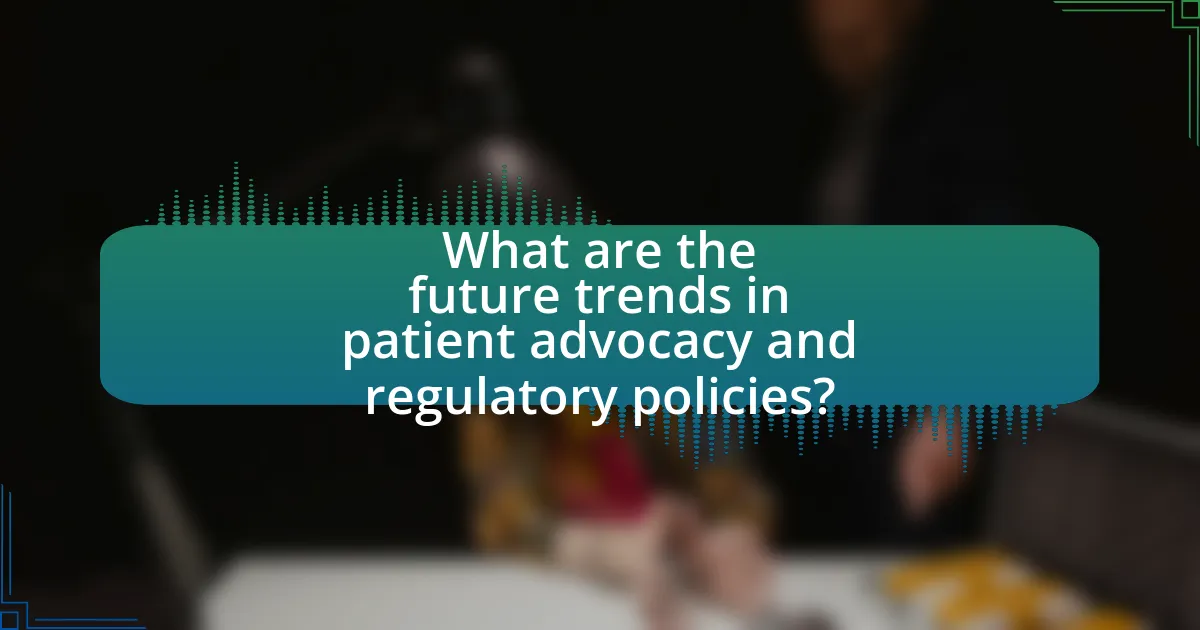Patient advocacy is a vital component in shaping regulatory policies within the healthcare sector, ensuring that patient voices and needs are represented in decision-making processes. This article explores how patient advocacy influences regulatory decision-making through education, representation, and collaboration, highlighting the mechanisms by which advocates gather and present patient perspectives. It also addresses the challenges faced by advocates, including resource limitations and public perception, while discussing strategies to enhance advocacy efforts and the role of technology in amplifying patient voices. Furthermore, the article examines future trends in patient advocacy, emphasizing the importance of personalized medicine and health equity in regulatory frameworks.

What is the Role of Patient Advocacy in Shaping Regulatory Policies?
Patient advocacy plays a crucial role in shaping regulatory policies by ensuring that the voices and needs of patients are represented in the decision-making processes. Patient advocacy groups actively engage with regulatory bodies, providing insights and data that reflect patient experiences and preferences, which can influence policy development. For instance, the Patient-Centered Outcomes Research Institute (PCORI) emphasizes the importance of patient input in research and regulatory decisions, demonstrating how advocacy can lead to more patient-focused outcomes. Additionally, studies have shown that when patients are involved in regulatory discussions, policies tend to better address real-world challenges faced by patients, leading to improved healthcare delivery and outcomes.
How does patient advocacy influence regulatory decision-making?
Patient advocacy significantly influences regulatory decision-making by ensuring that the perspectives and needs of patients are considered in the development of health policies and regulations. Advocacy groups often provide critical data and personal testimonies that highlight the real-world impact of medical products and services, which can sway regulatory bodies to prioritize patient-centered outcomes. For instance, the involvement of patient advocacy organizations in the FDA’s Patient-Focused Drug Development initiative has led to the incorporation of patient experiences into the evaluation of new therapies, demonstrating how advocacy can shape regulatory frameworks to be more responsive to patient needs.
What are the key mechanisms through which patient advocates operate?
Patient advocates operate primarily through education, representation, and collaboration. They educate patients about their rights and treatment options, ensuring informed decision-making. Representation involves advocating for patients’ needs and preferences in healthcare settings, influencing policy decisions that affect patient care. Collaboration with healthcare providers, regulatory bodies, and other stakeholders enables advocates to amplify patient voices and drive systemic change. These mechanisms are essential for shaping regulatory policies that prioritize patient-centered care and improve health outcomes.
How do patient advocates gather and present patient perspectives?
Patient advocates gather and present patient perspectives through various methods, including surveys, interviews, focus groups, and public forums. These approaches allow advocates to collect qualitative and quantitative data directly from patients about their experiences, needs, and preferences regarding healthcare. For instance, a study published in the Journal of Patient Experience highlighted that structured interviews with patients provided valuable insights that informed healthcare policy decisions. By synthesizing this information, patient advocates can effectively communicate the collective voice of patients to policymakers, ensuring that regulatory policies reflect real-world patient experiences and priorities.
Why is patient advocacy important in the regulatory landscape?
Patient advocacy is crucial in the regulatory landscape because it ensures that the voices and needs of patients are considered in policy-making processes. By representing patient perspectives, advocates can influence regulations that directly impact healthcare access, treatment options, and safety standards. For instance, the involvement of patient advocacy groups in the development of the 21st Century Cures Act led to increased funding for research and streamlined drug approval processes, demonstrating how patient input can shape effective regulatory frameworks.
What impact does patient advocacy have on policy outcomes?
Patient advocacy significantly influences policy outcomes by amplifying the voices of patients in the legislative process. Advocacy groups mobilize individuals to share their experiences, which can lead to increased awareness among policymakers about specific health issues. For instance, the American Cancer Society’s advocacy efforts contributed to the passage of the Affordable Care Act, which expanded healthcare access for millions. Additionally, research published in the Journal of Health Politics, Policy and Law indicates that patient advocacy can lead to more patient-centered policies, as seen in the development of the 21st Century Cures Act, which aimed to accelerate medical product development and bring innovations to patients faster. These examples demonstrate that patient advocacy not only raises awareness but also drives legislative change that directly impacts healthcare policies.
How does patient advocacy enhance the representation of diverse patient populations?
Patient advocacy enhances the representation of diverse patient populations by actively promoting the inclusion of varied voices in healthcare decision-making processes. Advocacy organizations work to identify and address the unique needs of underrepresented groups, ensuring that their perspectives are considered in policy development. For instance, studies have shown that patient advocacy groups can influence regulatory policies by providing data on health disparities, which leads to more equitable healthcare solutions. This representation is crucial for tailoring treatments and interventions that are culturally and contextually appropriate, ultimately improving health outcomes for diverse populations.

What are the challenges faced by patient advocates in regulatory processes?
Patient advocates face several challenges in regulatory processes, including limited access to decision-makers, insufficient funding, and a lack of understanding of regulatory frameworks. Limited access to key stakeholders can hinder their ability to influence policy effectively, as they may not have the same level of engagement as industry representatives. Insufficient funding restricts their capacity to conduct research, mobilize resources, and participate in advocacy efforts, which is crucial for representing patient interests. Additionally, a lack of understanding of complex regulatory frameworks can impede their ability to navigate the system and advocate effectively for patient needs. These challenges are documented in studies highlighting the barriers to effective patient engagement in regulatory decision-making.
What barriers do patient advocates encounter when engaging with regulators?
Patient advocates encounter several barriers when engaging with regulators, including limited access to decision-makers, lack of resources, and insufficient understanding of regulatory processes. Limited access to decision-makers often hinders advocates from effectively communicating patient needs and perspectives, as they may struggle to secure meetings or establish relationships with key regulatory personnel. Additionally, many patient advocacy organizations operate with constrained budgets and staffing, which restricts their ability to conduct research, mobilize support, or participate in advocacy efforts. Furthermore, a lack of familiarity with complex regulatory frameworks can impede advocates’ ability to navigate the system and effectively influence policy changes. These barriers collectively diminish the impact of patient advocacy in shaping regulatory policies.
How do resource limitations affect the effectiveness of patient advocacy?
Resource limitations significantly hinder the effectiveness of patient advocacy by restricting access to necessary tools, information, and support systems. When advocacy groups lack financial resources, they struggle to conduct research, engage in outreach, and mobilize community support, which are essential for influencing regulatory policies. For instance, a study by the National Health Council found that organizations with limited budgets often cannot afford to hire skilled personnel or invest in effective communication strategies, resulting in diminished advocacy impact. Additionally, resource constraints can lead to inadequate representation of patient voices in policy discussions, ultimately affecting the quality of healthcare regulations.
What role does public perception play in the challenges faced by advocates?
Public perception significantly influences the challenges faced by advocates by shaping the level of support or opposition they encounter. When the public views advocacy efforts positively, advocates can mobilize resources, gain media attention, and influence policymakers more effectively. Conversely, negative public perception can lead to skepticism about the advocates’ motives, diminish credibility, and hinder their ability to effect change. For instance, a study by the Pew Research Center found that public trust in advocacy organizations directly correlates with their effectiveness in influencing health policy. Thus, advocates must navigate the complexities of public opinion to overcome barriers and achieve their goals.
How can patient advocates overcome these challenges?
Patient advocates can overcome challenges by building strong coalitions with healthcare professionals, policymakers, and other stakeholders. These coalitions enhance their influence and provide a unified voice in regulatory discussions. For instance, the Patient-Centered Outcomes Research Institute (PCORI) emphasizes the importance of collaboration between patients and researchers to ensure that patient perspectives are integrated into health policy decisions. Additionally, advocates can utilize data and evidence-based research to support their positions, thereby increasing credibility and effectiveness in negotiations. By leveraging these strategies, patient advocates can effectively navigate obstacles and drive meaningful change in regulatory policies.
What strategies can be employed to enhance advocacy efforts?
To enhance advocacy efforts, organizations can employ strategies such as building coalitions, utilizing data-driven storytelling, and engaging in grassroots mobilization. Building coalitions allows diverse stakeholders to unite, amplifying their collective voice and influence in regulatory discussions. Data-driven storytelling leverages statistics and personal narratives to create compelling cases that resonate with policymakers and the public, thereby increasing the impact of advocacy messages. Grassroots mobilization encourages community involvement, fostering a sense of ownership and urgency around advocacy issues, which can lead to increased pressure on decision-makers. These strategies have been shown to effectively elevate advocacy efforts, as evidenced by successful campaigns that resulted in significant policy changes, such as the Affordable Care Act, which was influenced by coordinated advocacy from various health organizations.
How can collaboration with other stakeholders improve advocacy outcomes?
Collaboration with other stakeholders can significantly improve advocacy outcomes by leveraging diverse expertise and resources to create a unified voice. When patient advocacy groups partner with healthcare providers, policymakers, and industry representatives, they can enhance their credibility and influence in shaping regulatory policies. For instance, a study published in the Journal of Health Politics, Policy and Law found that coalitions involving multiple stakeholders were more effective in advocating for policy changes than isolated efforts. This collaborative approach allows for the sharing of data, experiences, and strategies, ultimately leading to more comprehensive and impactful advocacy initiatives.

What are the future trends in patient advocacy and regulatory policies?
Future trends in patient advocacy and regulatory policies include increased collaboration between patients, healthcare providers, and regulatory bodies, as well as a greater emphasis on personalized medicine and health equity. This shift is driven by the growing recognition of patients as key stakeholders in the healthcare system, leading to more inclusive decision-making processes. For instance, the FDA has implemented initiatives like the Patient Engagement Advisory Committee to incorporate patient perspectives into regulatory decisions. Additionally, the rise of digital health technologies is facilitating real-time patient feedback, which can influence regulatory frameworks and policies. These trends reflect a broader movement towards transparency and accountability in healthcare, ensuring that patient voices are integral to shaping effective regulatory policies.
How is technology shaping the role of patient advocacy?
Technology is significantly enhancing the role of patient advocacy by providing tools for better communication, data sharing, and access to information. Digital platforms enable advocates to connect with patients, gather their experiences, and amplify their voices in regulatory discussions. For instance, social media allows for real-time engagement and mobilization of patient communities, while telehealth technologies facilitate access to healthcare resources, empowering patients to advocate for their needs. Additionally, data analytics tools help advocates analyze patient outcomes and trends, which can inform policy recommendations. This integration of technology not only streamlines advocacy efforts but also ensures that patient perspectives are more effectively represented in shaping regulatory policies.
What digital tools are being utilized by patient advocates?
Patient advocates utilize various digital tools, including social media platforms, online forums, telehealth services, and advocacy-specific software. Social media platforms like Twitter and Facebook enable advocates to raise awareness and mobilize support for health issues, while online forums provide spaces for sharing experiences and information. Telehealth services facilitate direct communication between patients and healthcare providers, enhancing access to care. Advocacy-specific software, such as tools for tracking legislation and organizing campaigns, helps advocates effectively engage with policymakers. These tools collectively empower patient advocates to influence regulatory policies and improve patient outcomes.
How can social media amplify patient voices in regulatory discussions?
Social media can amplify patient voices in regulatory discussions by providing a platform for widespread communication and engagement. This digital space allows patients to share their experiences, concerns, and insights directly with regulators and the public, fostering transparency and dialogue. For instance, campaigns on platforms like Twitter and Facebook have mobilized patient communities, leading to increased visibility of specific health issues and influencing policy decisions. A notable example is the #PatientsIncluded movement, which advocates for patient involvement in clinical trials and regulatory processes, demonstrating how social media can effectively unite patient voices to impact regulatory frameworks.
What emerging issues should patient advocates focus on?
Patient advocates should focus on the integration of digital health technologies, health equity, and mental health access as emerging issues. The rise of telehealth and mobile health applications necessitates advocacy for patient privacy, data security, and equitable access to these technologies. Additionally, health equity remains critical, as disparities in healthcare access and outcomes persist among marginalized communities, highlighting the need for policies that address social determinants of health. Mental health access is increasingly recognized as essential, especially in the wake of the COVID-19 pandemic, which exacerbated mental health issues and revealed gaps in care. These areas are supported by research indicating that digital health can improve access but also raises concerns about privacy (Source: Health Affairs, “The Role of Digital Health in Addressing Health Disparities,” authors: Smith et al., 2022).
How can patient advocacy adapt to changes in healthcare regulations?
Patient advocacy can adapt to changes in healthcare regulations by actively engaging in policy discussions and leveraging data to influence decision-making. This involves monitoring regulatory updates, collaborating with healthcare organizations, and utilizing evidence-based research to advocate for patient rights and needs. For instance, organizations like the National Patient Advocate Foundation have successfully influenced legislation by presenting patient-centered data, demonstrating the effectiveness of advocacy in shaping regulatory policies.
What role will patient advocacy play in the evolution of personalized medicine?
Patient advocacy will play a crucial role in the evolution of personalized medicine by ensuring that patient voices and needs are integrated into the development and implementation of tailored therapies. Advocacy groups actively influence regulatory policies, pushing for guidelines that prioritize patient-centered approaches, which can lead to more effective and accessible personalized treatments. For instance, the FDA has increasingly engaged with patient advocacy organizations to gather insights on patient experiences and preferences, as seen in initiatives like the Patient-Focused Drug Development program. This collaboration helps shape research priorities and regulatory frameworks, ultimately enhancing the relevance and efficacy of personalized medicine.
What best practices can enhance the effectiveness of patient advocacy?
Effective patient advocacy can be enhanced through clear communication, collaboration with healthcare professionals, and leveraging data to support patient needs. Clear communication ensures that patient concerns are accurately conveyed and understood, fostering trust and transparency. Collaboration with healthcare professionals allows advocates to align their efforts with clinical insights, enhancing the relevance and impact of advocacy initiatives. Utilizing data, such as patient outcomes and demographic information, strengthens advocacy efforts by providing evidence-based support for policy changes. For instance, studies have shown that data-driven advocacy can lead to more effective health policies, as evidenced by the work of organizations like the Patient Advocate Foundation, which uses patient data to influence healthcare reforms.
How can patient advocates effectively communicate their messages to regulators?
Patient advocates can effectively communicate their messages to regulators by utilizing clear, data-driven narratives that highlight patient experiences and needs. This approach ensures that the advocates present compelling evidence, such as statistics on patient outcomes or testimonials that illustrate the impact of regulatory decisions on real lives. For instance, a study published in the Journal of Health Policy found that patient-centered advocacy significantly influenced regulatory outcomes when advocates presented concrete data alongside personal stories. By combining quantitative evidence with qualitative experiences, patient advocates can create a persuasive case that resonates with regulators, ultimately shaping policies that prioritize patient welfare.
What are the key elements of successful advocacy campaigns?
Successful advocacy campaigns are characterized by clear objectives, strategic messaging, strong coalitions, effective communication, and measurable outcomes. Clear objectives define the specific goals of the campaign, ensuring that all efforts are aligned towards achieving a common purpose. Strategic messaging tailors the communication to resonate with the target audience, enhancing engagement and support. Strong coalitions leverage partnerships with various stakeholders, amplifying the campaign’s reach and influence. Effective communication utilizes multiple channels to disseminate information and mobilize supporters, while measurable outcomes allow for the assessment of the campaign’s impact and effectiveness. These elements collectively contribute to the success of advocacy efforts in shaping regulatory policies.




